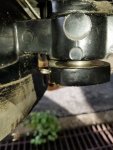That's an interesting question... I really don't know. I haven't read too many threads here where that gasket was the culprit. If it fails that much, I'd be surprised that Mercruiser still uses that design. I do know that anytime I see sealant around the gimbal housing, I've always assumed it's a half-baked attempt to solve a leak caused by a bad transom.
It would be interesting to hear how many people routinely use some kind of sealant between the transom and that gasket.
Most transom are not perfectly flat. I believe MC allows 1/8" difference (total) on I/O holes. Many people don't really take into consideration the enormous strain V8 i/os or OBs put on transoms. I have a friend whose transom flexes with his 200+ HP Yamaha. The boat is a 1992. Water comes out of some of screw holes. I fear he is living on borrowed time. But, he is always poor-mouthing me about getting it fixed.
The MC design is simple, effective and inexpensive, but every gimbal housing that I have pulled, the gasket has been flattened and lost its elasticity. I have also examined other gimbal houses from friends, etc. , that were flattened. I suspect that MC doesn't worry about it after the sale. Remember! They sell replacement parts. The gaskets are also somewhat difficult to keep in gimbal grove while attaching to a transom w/o some sort of caulk, sealant, etc.
Bleach will weaken or destroy pure silicon caulk. And, most of us use bleach to clean boats, especially in mildew ridden Florida. If you don't like the prospect of the laborious work required removing a gimbal housing later on in life that had 5200 holding the o-ring gasket in place, then use something less permanent. Any caulk applied around the Gimbal housing transom mating area looks like crap, but it will also give you a warm fizzy feeling of added protection. Good luck!






















